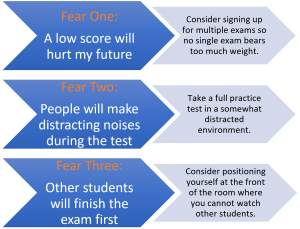Note: This is part 2 of a 4-part series on overcoming common barriers to learning. Tune in every Thursday for more insight from our Manager of Instruction, Jodie Westerman.
Last week we looked at how to empower students to adopt a growth mindset toward their learning. Now let’s consider students who struggle with a different sort of challenge: test anxiety. This dreadful, unnerving, and even paralyzing feeling comes in many shapes and sizes, from the student who feels too anxious to concentrate when the stakes are high to the student who feels drained of energy the second an exam begins. Yet despite these differences, students with test anxiety have one thing in common: the false belief that they will not succeed under real exam conditions.
Today we’ll look at some common ways test prep students experience test anxiety and how our tutors use proven pedagogical theory to position these students for success.
What does test anxiety look like in test prep students?
Test anxiety—not to be confused with typical test jitters—is a physiological response a student can experience during high pressure exams. Often referred to as “fight or flight mode,” the body’s response to test anxiety mirrors a physical response to danger: heart rate elevates, breathing rate increases, and stress hormone production skyrockets. Obviously, these conditions do not produce ideal test-taking conditions or performance. In fact, research shows that students with test anxiety score on average about 12 percentile points below other students. It is therefore important that educators and families work to identify and resolve issues of test anxiety as early as possible. But how do we differentiate between a student with test anxiety and a student who is simply not doing her best work?
One indicator is the difference between work completed at home and work completed under high-pressure conditions such as standardized tests. As a professional tutor, I’ve worked with hundreds of students, and most of these students perform about as well on exams and other forms of assessment as they do on homework and in-session exercises. Occasionally, however, a student will earn high marks on homework and low-pressure practice tests only to fall far short of these metrics on timed or monitored tests. When this happens, I immediately wonder if test anxiety could be the culprit.
Of course, there are several instances in which performance gaps are nothing more than isolated events. Perhaps the student had a bad test day or simply wasn’t feeling her best. A much more reliable way to spot anxiety is to listen to the student herself. Does the student describe an upcoming exam with angst and dread? Does she anticipate failure before it even happens? If so, there is a strong chance the student has developed negative associations with exams and will need to adopt a fresh perspective to reach her potential.
What is Self-Perception Theory?
There is a longstanding belief in the field of psychology that a person’s attitudes drive her behavior. This traditional view assumes that our behavior reflects our inner beliefs and that to change our behavior, we must change our beliefs. But what if it’s the other way around? What if our behavior has the power to shape our beliefs? Self-perception theory considers this possibility.
The theory of self-perception states that people can develop attitudes and opinions based on observing their own behavior. For example, someone who tries rock climbing for the first time and reaches the top of the wall is likely to believe she’s pretty good at rock climbing, whereas someone who tries rock climbing and falls before even getting off the ground may assume rock climbing is not her forte. In both cases, the new rock climbers had no preexisting beliefs about rock climbing. Yet their different experiences led them to conclude something about themselves—whether they were “good” or “bad.”

How do ArborBridge tutors encourage less anxious test-taking behavior?
When it comes to test prep, we find that focusing on behavior can produce faster and more effective results than addressing the underlying beliefs alone. Students with test anxiety have a lifetime of negative attitudes toward tests, and it’s not likely that we can change those beliefs with a simple word of encouragement. Rather, we need to show the student how successful she can be in a timed testing environment. ArborBridge tutors do this in a few different ways:
1) Targeted practice
During targeted practice, a tutor selects a single strategy or concept to focus on with his student. The tutor and student explore this concept in-depth and ensure the student understands it inside and out. Once the student demonstrates sufficient understanding of the skill, the tutor will assign the student a timed drill with very specific instructions: focus on the new skill and only the new skill. By giving the student such specific instructions, the tutor helps his student stop focusing on the testing experience in general and start focusing on the specific task at hand. When the student performs well, she understands that she not only learned a new skill but also can successfully apply it under timed conditions.
2) Realistic practice
One of the biggest mistakes a test prep student can make is to take practice tests under unrealistic conditions. When it comes to practice, all students—especially those prone to anxiety—should replicate official exam conditions as closely as possible. By successfully completing practice tests that mirror official exams, students with anxiety will clearly see that they are capable of high performance, even under strenuous conditions. Here are several ways to create a more realistic testing experience:
- Print exams in full
- Take entire exam in one sitting
- Bubble answers on a grid (do not simply circle answers in your booklet)
- Limit your breaks to what’s permitted on the actual exam
- Eat snacks and drink water during breaks, not during the exam
- Take exams in multiple locations (learn to cope in different environments)
- Turn your phone off
3) Personalized practice
At ArborBridge, we understand that no two students are alike. This means that no two students’ anxieties will function the exact same way, either. To create a personalized plan to beat anxiety, we first work to understand the cause. For some students, anxiety stems from fear: fear of not getting into college, fear of disappointing an authority figure, or fear of disappointing themselves. For other students, anxiety might stem from more physical concerns. If a student is easily distracted by loud noises, she may worry about a noisy testing environment. If a student is easily unnerved by other students, she may dread interactions with them on her way into the testing site. Many students think that these problems are completely outside of their control. But that’s not true! By acknowledging the source of the anxiety, students, tutors, and education professionals can work together to identify concrete actions students can take to combat anxiety. Let’s consider some common student fears and possible solutions.

What does this mean for students?
If you are struggling with test anxiety, please know there is a solution. Your hard work can and will translate to higher test scores; you just need to show yourself it’s possible. Start by working with a tutor, educational professional, or trusted adult to make a game plan. Remember to create opportunities to experience success through targeted, realistic, and personalized practice. Finally, remember that your fears are valid, but they are not insurmountable. By thinking ahead, you too can get the score and results you deserve!






